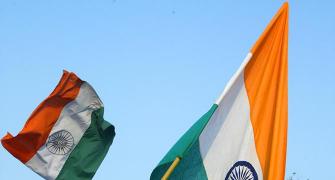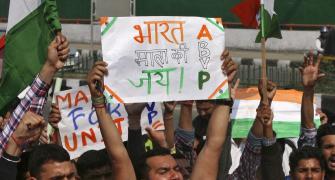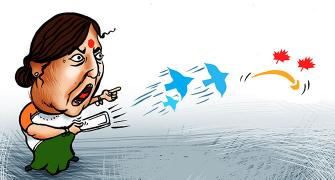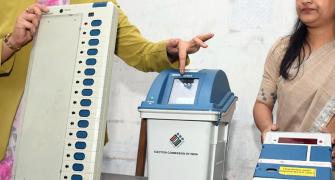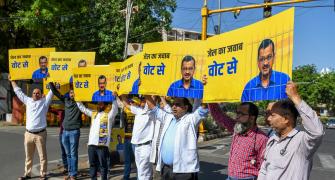'I remember the confusion over the slogan, 'Karenge Ya Marenge! (Do Or Die!)'.'
'I think this confusion arose because Gandhiji was arrested.'
'People used to wonder: What are we supposed to do?'
'How are we supposed to die?'
'How are we to fight the British?'
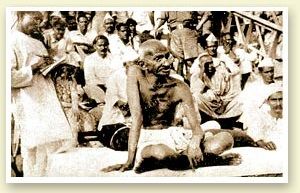
M V Kamath, the distinguished journalist, reminisced about the Quit India movement.
This feature was first published on Rediff.com on August 6, 2002. Mr Kamath, who has since passed into the ages, spoke to Syed Firdaus Ashraf/Rediff.com
I had finished college and was working as a chemist at Kemp's Corner (near Gowalia Tank, since renamed August Kranti Maidan, in south Mumbai). The year was 1942.
I was 21 years old. Patriotism was in the air and the Congress for us could do no wrong.
On the night of August 8, all senior Congress leaders -- including Mahatma Gandhi -- were arrested.
Kasturba Gandhi, the Mahatma's wife, who was supposed to address a meeting at Shivaji Park (a few kilometres away) the next day, was also arrested before the meeting could take place.
Thousands of people had already begun to gather there, leading to utter confusion the whole day.
There was a lathi-charge -- I think even tear gas was used -- by the police at Gowalia Tank, where people had again gathered in huge numbers.
The streets were choked with people.
We didn't know what to do next. Nobody had any idea what was going on.
Gandhiji had given no directions; I think he never expected he would be arrested.
Some people cut off the telegraph wires and disrupted rail traffic.
There was absolute chaos in the country.
I remember the confusion over the slogan, 'Karenge Ya Marenge! (Do Or Die!)'.
I think this confusion arose because Gandhiji was arrested.
People used to wonder: What are we supposed to do?
How are we supposed to die?
How are we to fight the British?
I had noted down in my diary that, with Mahatma Gandhi's arrest, the British had endangered his life.
I felt there would be labour strikes, mills would close and, shortly thereafter, there would be bloodshed.
A torch of rebellion was lit and the fire would soon spread all over India and arouse 40 crore (400 million) Indians.
All of them will have only one slogan: 'Do Or Die'.

After August 9, someone dropped 50 news bulletins giving information about the Quit India movement at my house by 5.30 am.
I would distribute them at different houses and run away.
I did that for some 30 days; then, the whole thing stopped.
On August 25, I came across a pamphlet listing the tasks before students. It said:
(Passive): Be Indian in both culture and life.
Boycott schools and colleges.
Boycott foreigners on our soil.
Boycott anti-national newspapers.
Organise the freedom movement in towns and villages.
Educate the children and the public.
(Active): Paralyse government services.
Persuade government servants to quit their jobs.
Damage lorries carrying troops and war goods.
Cut communication wires and remove rails.
The tasks before the workers were:
(Passive): Cease working in mills, factories and workshops.
Establish villages.
Produce village-made articles.
Spin and weave.
(Active): Same as items meant for students.
The tasks before the ladies were:
(Passive): Spin and weave.
Educate the children.
Nurse the wounded and injured.
Collect funds for patriots.
(Active): Organise women in towns and villages.
Persuade government servants to give up their jobs.
Gain support for our movement by all honourable means.
Paralyse government services.
The Quit India Movement was different from Gandhiji's earlier movements in the sense that, earlier, everybody knew what they had to do.
For example, during the Salt Satyagraha, people knew they had to go to sea, manufacture salt and sell it.
But on August 9 there was no such directive. I still don't know who gave those instructions. It was very secretive. I don't even know who printed the news bulletins that I distributed.
Aruna Asaf Ali and Jayaprakash Narayan were two important leaders of the Quit India movement. Asaf Ali, whose form of protest was violent, was finally arrested. When she was released, she took charge of the naval mutiny.
Jayaprakash too was arrested, but escaped from jail. Both of them were great heroes of our time.
We had no clue then that we were so close to Independence. Even in 1946, we were not sure if we would be free.

